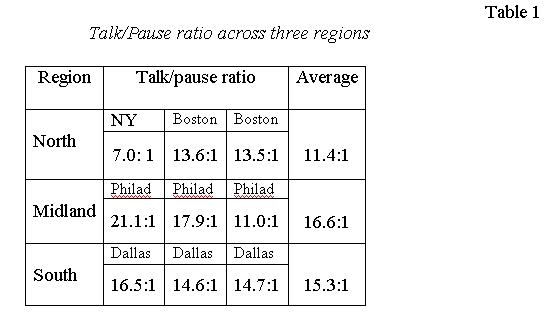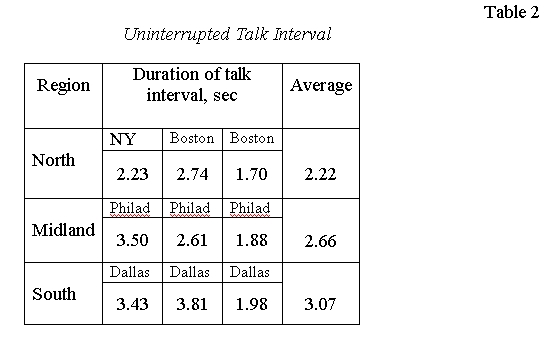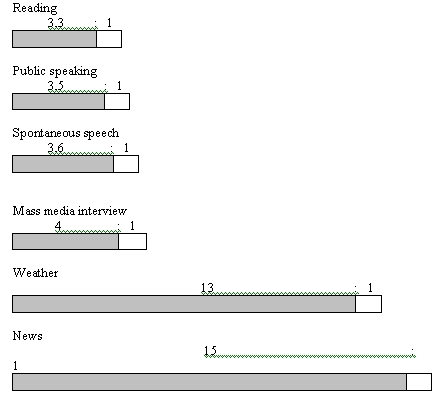ASA/CAA '05 Meeting, Vancouver, BC



Not So Fast, Please: Temporal Features in TV Speech
Natalia Uglova - nataly_uglova@mail.ru
Tatiana Shevchenko
Moscow State Linguistic University
Linguistic Department
Popular version of paper 4aSC19
Presented Thursday morning, May 19, 2005
Joint ASA/CAA Meeting, Vancouver, BC
Introduction
Do you have a feeling that our tempo of speech accelerates all the time? The
media, it seems, have already exceeded all limits in human speech delivery and
perception. It's not that they talk too fast; they just don't give us a chance
to digest what we hear. In TV news and weather programs the ratio of an uninterrupted
speech interval to a pause is 14 to 1, as compared with the ratio of around
3 to 1 in normal conversational speech.
What are the sources?
We studied authentic TV speech. The videotaped corpus was collected in Boston
(NBC), New York (NBC Nightly News with Tom Brokaw), Philadelphia (Good Day,
Philadelphia!) and Dallas (Texas News Channel 5) in the years 1997 - 2001. We
looked at nine samples all in all, spoken by nine newscasters, 5 men and 4 women.
Each sample is approximately one minute in duration, or around 200 words long.
When processed and tabulated, the acoustic data, in particular speech-to-pause
ratios, were correlated with the geographical origin, type of program and gender
of the speakers.
Southern drawl? - No, sir. Quite standard.
Geographically, the North - Midland - South affiliation of newsreaders can be
correlated with their rate of speech. Averaged over the regional groups, the
ratio of the time spent in talking, as set against the time spent in silence,
suggests that the most salient common feature is dominance of talking: 11.4:1,
16.6:1, 15.3:1 (see Table 1).

By looking at the average uninterrupted interval of talk we can find that there is a gradual slowdown in tempo towards the South: 2.22 sec, 2.66 sec, 3.07 sec. However, individual values may vary a great deal (see Table 2).

Thus, the anchors from all the regions can be stated to have a standard-like manner of delivering the information.
News vs. Weather: Which is faster?
Analyzing two types of programs, news and weather forecast, reveals a greater tempo of the weathercaster's speech. Thus, the duration of the uninterrupted talk interval in news items is 3.07 sec and in weather talks - 1.85 sec. The ratio of talk/pause is 15:1 in news and 13:1 in weather. The number of accented syllables per minute is 117.5 in news versus 130.7 in weather. The validity of information in news is certainly greater than in weather forecasts. The TV speech rate appears even more striking when we take a look at the data obtained in previous research based on other styles: reading, public speaking, spontaneous monologue and mass media interview. In reading a text or a political speech, as well as in spontaneous monologue, the ratio is around 3.5 to 1. In a mass media interview it is 4 to 1. (Fig. 1)

Women are just as good
The proverbial fluency of women in speech didn't show up in newsreading. The only specific feature of women newsreaders is lack of pauses of middle duration: they utilize exclusively short and extra short pauses. Women do spend a little less time in thinking, but here reading the news puts all the anchors in equal circumstances of time constraints.
How are we coping?
Information programs are intended to contain the most important, "top"
news. Highlighting the major items is achieved through accent location and pitch
change as the acoustic cues which help us pick them out. The average number
of accents within the uninterrupted chunks of speech is 6 in newscasting versus
2-3 in other styles, reading and spontaneous talk.
Summing up
Thus we can re-state the basic findings: newsreader delivery is based on squeezing
a lot of information, up to 6 accented items on the average within a 2-3 second
time interval which is followed by a short or an extra-short pause. Given the
time constraints and the running text to speed them up the newscasters still
give us a chance to pick out the main information points by accenting them,
without slowing down a bit. We have to rely on visual input and our background
knowledge to make sense of the rest of a news item. Or perhaps are the additional
details considered to be a restatement of the main point and we are not supposed
even to make an effort to grasp them?